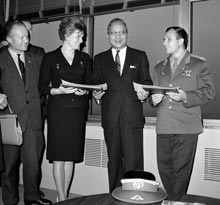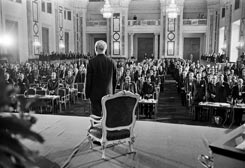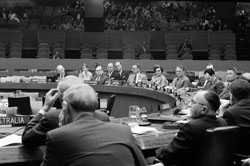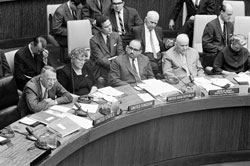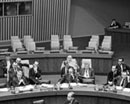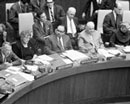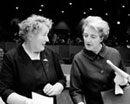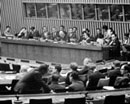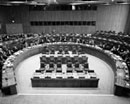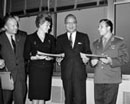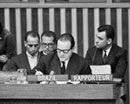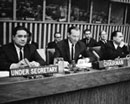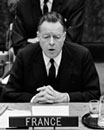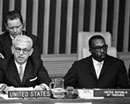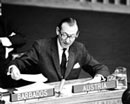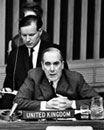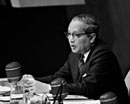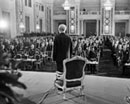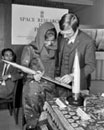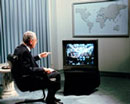|
Treaty on Principles Governing the Activities of States in the Exploration and Use of Outer Space, including the Moon and Other Celestial Bodies
New York, 19 December 1966
By Vladimír Kopal
Professor of International Law, West Bohemian University, Pilsen, Czech Republic, Chairman, Legal Subcommittee of the Committee on the Peaceful Uses of Outer Space (1999 to 2004 and 2008 to 2010)
Introduction
The Treaty on Principles Governing the Activities of States in the Exploration and Use of Outer Space, Including the Moon and Other Celestial Bodies, which is usually called the Outer Space Treaty, is one of the most significant law-making treaties concluded in the second half of the twentieth century. It was adopted by the United Nations General Assembly on 19 December 1966 (resolution 2222 (XXI)), opened for signature at London, Moscow and Washington on 27 January 1967, and entered into force on 10 October 1967. The Outer Space Treaty laid down the foundations of international regulation of space activities and thus established the framework of the present legal regime of outer space and celestial bodies. As of 1 January 2008, the Outer Space Treaty has received 99 ratifications and 25 signatures.
When the COPUOS and its Legal Subcommittee began their consideration of the topic, it was understood that the rule of law in outer space should be developed step by step in harmony with the actual needs of international cooperation in this new area of human activity and that all decisions in this regard should be adopted by consensus. Among the documents submitted to the first session of the Legal Subcommittee in the spring of 1962 was a draft Declaration of the Basic Principles Governing the Activities of States Pertaining to the Exploration and Use of Outer Space proposed by the Union of Soviet Socialist Republics (USSR) (A/AC.105/C.2/L.1). The proposal contained a set of rules considered by its sponsor as fundamental for any activities conducted in outer space or expected to be conducted there in the future. The draft Declaration and, in particular, some of the principles therein, did not immediately find the support of all the COPUOS member States. Nevertheless, the idea gained ground and, in 1963, such a Declaration was successfully negotiated. The Declaration of Legal Principles Governing the Activities of States in the Exploration and Use of Outer Space was approved by the General Assembly in its resolution 1962 (XVIII), adopted by consensus on 13 December 1963. The 1963 Declaration included a set of general principles which characterized the legal status of outer space and celestial bodies and outlined the scope of legality for activities of States in the space environment. It also provided initial rules for handling some already known problems of the space activities undertaken at that time, thus creating starting points for a further regulation of space projects by space law. As a General Assembly resolution, the Declaration could not establish binding norms of international law. Nevertheless, already during the period of its adoption, it was considered to be the basis for a future legally binding treaty. That expectation soon became a reality, accelerated by the ongoing race between two major space powers to reach the Moon. After a short diplomatic overture, the following proposals were submitted by them on 16 June 1966: a draft Treaty Governing the Exploration of the Moon and Other Celestial Bodies by the United States; (A/AC.105/32); and a draft Treaty on Principles Governing the Activities of States in Exploration and Use of Outer Space, the Moon and Other Celestial Bodies by the USSR (A/6352). Fortunately, it was possible to surmount the difference between the scope of the two initiatives by a general acceptance of the wider approach to the subject, which was balanced by some other concessions. Discussions on the agreed subject began at the fifth session of the Legal Subcommittee in Geneva, starting from 12 July 1966, and continued the same year in September in New York. The discussions dealt with two categories of topics: the first concerned fundamental principles, the essence of which had already been spelled out in the 1963 Declaration and could now be transferred with some additions and minor changes into the draft Treaty; the second elaborated the principle of international cooperation in space activities and dealt with some specific issues relating to the implementation of that principle. It is interesting to note that owing to the preliminary discussions during the negotiations of the 1963 Declaration and the conclusion thereof, it became easier to reach agreement on fundamental principles in the draft Treaty, whereas some more specific questions relating to the second category of topics led to controversial and sometimes lengthy discussions. A number of such issues were reconciled only during the final stages of the negotiations by informal consultations between the representatives of the two major space powers with the participation of United Nations Secretary-General U Thant, the COPUOS Chairman, Kurt Waldheim of Austria, and the Chairman of the COPUOS Legal Subcommittee, Manfred Lachs of Poland. From among several preambular paragraphs of the Treaty, two paragraphs should in particular be recalled since they spell out the purposes for concluding the Outer Space Treaty in an outstanding manner: the desire “to contribute to broad international cooperation in the scientific as well as the legal aspects of the exploration and use of outer space for peaceful purposes”; and the belief “that such cooperation will contribute to the development of mutual understanding and to the strengthening of friendly relations between States and peoples”. Both adequately reflect the historical conditions of the origin of the Outer Space Treaty, which was not only a response to the scientific and technical needs of that epoch, but also a substantive contribution to a détente in the cold war. From the language of the first three articles of the Outer Space Treaty the following elements can be derived: (a) Recognition of the common interest of mankind in the exploration and use of outer space, including the Moon and other celestial bodies, as an area for space activities of all countries, without any difference in their economic and scientific development; such exploration and use having become “the province of all mankind” ; (b) Recognition of the freedom of outer space, including the Moon and other celestial bodies, for exploration and use by all States, on a basis of equality and in accordance with international law; (c) Stipulation of free access to all areas of celestial bodies; (d) Recognition of the freedom of scientific investigation in outer space, including the Moon and other celestial bodies, and promotion of international cooperation in such investigation; (e) Renunciation of national appropriation of outer space, including the Moon and other celestial bodies, by any means; and (f) Confirmation of the applicability of international law, including the Charter of the United Nations, to activities in the exploration and use of outer space, the Moon and other celestial bodies, in the interest of maintaining peace and security and promoting international cooperation and understanding. In connection with the fundamental principles of the Outer Space Treaty, its article VI must also be highlighted: it declared the principle of international responsibility of States for national space activities, whether such activities are carried on by governmental agencies or by non-governmental entities, and for assuring that national activities are carried out in conformity with the provisions of the Outer Space Treaty. This principle, which had already appeared in the 1963 Declaration, was a compromise formula that reconciled the controversial views of those wishing to reserve space activities only for States and intergovernmental organizations, and those advocating access to outer space also for non-governmental entities. By adopting this principle, the negotiating States paved the way for the private sector to conduct space activities side by side with States and international intergovernmental organizations. At the same time, however, the respective States assumed responsibility not only for their own space activities, but also for the activities of private legal persons of their nationality. States parties have also become responsible for assuring that all national activities of this nature would be carried out in conformity with the provisions of the Outer Space Treaty. The activities of non-governmental entities in outer space, including the Moon and other celestial bodies, require authorization and continuing supervision by the respective States parties to the Outer Space Treaty. When space activities are carried on by an international organization, responsibility for compliance with the Outer Space Treaty shall be borne by the international organization and by the States parties to the Treaty participating in such organization. The Outer Space Treaty then turns to the regulation of special issues relating to and connected with some particular aspects of space activities. The first among them was the problem of limiting military activities in outer space. Article IV of the Outer Space Treaty confirmed the undertaking, which had already been made in United Nations General Assembly resolution 1884 (XVIII) of 17 October 1963, not to place in orbit around the Earth any objects carrying nuclear weapons or any other kinds of weapons of mass destruction, install such weapons on celestial bodies, or station them in outer space in any other manner. This principle relates to outer space as a whole, i.e., including the Moon and other celestial bodies. In conjunction with the 1963 Moscow Treaty, which was the product of the same period of détente, and which prohibited, inter alia, any nuclear weapons test explosions or any other nuclear explosions beyond the limits of the atmosphere “including outer space”, the Outer Space Treaty established an immense denuclearized area surrounding the planet Earth. The second paragraph of article IV stipulates that the Moon and other celestial bodies shall be used by the parties to the Outer Space Treaty exclusively for peaceful purposes, thus providing a complete prohibition against activities undertaken for military purposes in these areas. This general principle is accompanied by a prohibition of some specific types of military activities. However, the use of military personnel and any equipment or facility for scientific research and other peaceful purposes is explicitly exempted from such prohibition. In this regard, it should be recalled that the 1959 Antarctic Treaty contains a similar proviso relating to activities undertaken for peaceful purposes in the Antarctica. Simultaneously with its preparation of the Outer Space Treaty, the Legal Subcommittee also discussed two other topics – Assistance to and Rescue of Astronauts, and Liability for Damage Caused by Space Objects. It was expected that more detailed negotiations on these items would continue after the finalization of the draft Outer Space Treaty and therefore the Treaty remained limited to basic principles relating to these subjects as their substance had already been enshrined in the last two paragraphs of the 1963 Declaration. Similarly, article VIII of the Outer Space Treaty established the principle that the State on whose registry an object launched into outer space is carried shall retain jurisdiction and control over such object, and over any personnel thereof, while in outer space or on a celestial body. By analogy with air and maritime law, this principle provided a basis for registration of space objects and established a link between the registration and the exercise of jurisdiction of the State of registry over the respective object. The same article preserves ownership of space objects, and of their component parts, which shall not be affected by their presence in outer space or on a celestial body or by their return to the Earth. Such objects or component parts, when found beyond the limits of the State of registry, shall be returned to that State upon its request. Some other topics, however, were more controversial. Those topics, which are addressed in general terms in the first part of article IX, concerned particularly the nature and extent of international cooperation, mutual assistance and due regard to the interests of all other States parties. As is evidenced from the remaining provisions of article IX and subsequent articles, such cooperation is not made obligatory, but depends on further consultations and agreements. One of the problems that arose during the negotiations concerned a request to include a most-favoured-nation clause in article X, which would guarantee all launching States parties an opportunity to observe the flight of their space objects from the territory of foreign States, if such an opportunity had already been afforded to other State or States with regard to their own objects. A way to resolve the problem was found in a rather vague commitment of States parties to consider on a basis of equality any such requests and to determine the nature of such an opportunity for observation and the conditions under which it could be afforded by agreement between the States concerned. Another problematic issue concerned informing the United Nations Secretary-General as well as the public and the international scientific community on the nature, conduct, locations and results of space activities by States parties to the Outer Space Treaty. The core of the problem was whether providing such information should be obligatory or voluntary. Eventually, the negotiating partners agreed that such information was to be provided “to the greatest extent feasible and practicable” and that the Secretary-General “should be prepared to disseminate it immediately and effectively” (article XI). Similarly, the issue of right of access to all stations, installations, equipment and space vehicles on the Moon and other celestial bodies by representatives of other States parties, or its dependence on certain conditions and measures to be fulfilled prior to such visits, had to be resolved by a compromise. Accordingly, the principle of openness of all such objects was accepted, but access was to be granted on a basis of reciprocity and after appropriate consultations (article XII). Less arduous, but still politically and juridically difficult, was the problem of participation of international intergovernmental organizations in the Outer Space Treaty. Particularly the COPUOS member States from among the Western European countries, which already engaged in close cooperation on space matters that later resulted in the establishment of the European Space Agency, insisted on a suitable solution to this issue. The solution eventually agreed to is found in the above-mentioned article VI, concerning the responsibility for activities of international space organizations, and in article XIII. According to the latter article, the provisions of the Outer Space Treaty shall apply to the activities of single States parties as well as to those conducted jointly with other States, “including cases where they are carried on within the framework of international intergovernmental organizations.” Practical questions arising from such situations were left to be resolved by the States parties to the Outer Space Treaty, either with the international organization concerned or States members of that international organization, which are parties to the Outer Space Treaty. Unfortunately, the approach that has been applied in subsequent United Nations space treaties to address this issue was not yet available during the negotiations on this major United Nations space instrument. This approach enables any international intergovernmental organization conducting space activities to make a declaration accepting the rights and obligations provided for in the treaty, if a majority of the States members of the organization are parties to such treaty. In contrast to subsequently concluded space treaties, such as the 1975 Registration Convention and the 1979 Moon Agreement, the depositary functions for the Outer Space Treaty were not entrusted to the Secretary-General of the United Nations. Instead, three Governments (USSR, United Kingdom and United States) assumed the depositary duties for this Treaty, a practice that was also employed by the 1968 Rescue Agreement and the 1972 Liability Convention. Though the Outer Space Treaty brought appropriate solutions to many difficult problems, it was not a comprehensive instrument that would comprise all existing and foreseeable aspects of space activities. Nor did it include clarifications necessary for a precise interpretation of some general terms used in that instrument. Thus, the Outer Space Treaty did not define terms such as “outer space”, “space object”, “orbit around the Earth”, “peaceful purposes”, “exploration and use of outer space” or “celestial bodies”. The Outer Space Treaty only provides rudimentary protection of the space environment, in a single sentence contained in article IX. Similarly, the protection of the Earth is mentioned only with regard to the introduction of extraterrestrial matter. It should be recalled, however, that a general concern for environmental problems in the United Nations, and the urgency of the risk of space debris generation in particular, emerged later. It is interesting to note that the Outer Space Treaty lacks any provisions that would regulate the methods of the settlement of eventual disputes, which usually appear in law-making treaties, such as the 1959 Antarctic Treaty. The reason for this omission is the difference of opinion that existed between the two major space powers and their supporters on introducing compulsory or only facultative dispute settlement methods. Little effort was devoted to resolving this widely known issue and the consultations provided for in article IX became the only applicable method to prevent or remove any problems in the mutual relations between the States parties to the Treaty. The Outer Space Treaty does not contain any principles that would regulate economic activities for the purpose of exploring and exploiting the natural resources of outer space, the Moon and other celestial bodies, or of producing energy from outer space for commercial purposes. At the time of the elaboration of the Treaty, such problems still seemed to be too remote and even a preliminary discussion on them might have raised obstacles to reaching final agreement on the Treaty, which was considered as urgent by all.
While following the conclusion of the Moon Agreement the treaty-making process with regard to the outer space in the United Nations was discontinued, it did not represent the end of the endeavours undertaken by the COPUOS and its Legal Subcommittee in the legal field of space exploration. Instead of attempting to regulate further emerging issues by legally binding instruments, the United Nations turned to a progressive elaboration of sets of principles to be adopted by the General Assembly, having only a recommendatory value. The following documents were adopted by the United Nations General Assembly:
In recent years, the COPUOS and its Legal Subcommittee have considered some specific problems relating to the interpretation and application of the Outer Space Treaty and of the Liability and Registration Conventions. These efforts led to the drafting of two special General Assembly resolutions, one dealing with the Application of the concept of the “launching State”, the other with recommendations on enhancing the practice of States and international intergovernmental organizations in registering space objects. The General Assembly adopted them by consensus on 10 December 2004 (resolution 59/115) and on 17 December 2007 (resolution 62/101), respectively. In the most recent period, the attention of the Legal Subcommittee has concentrated on the role of national legislation of individual States in ensuring the legality of space activities. This is the way in which the whole present system of space law has been growing. It comprises principles and rules of international space law established by the United Nations, the 1967 Outer Space Treaty being its basic source; principles and rules promulgated by other international organizations in accordance with their functions in the field of space activities; and multilateral and bilateral agreements on cooperation in space activities concluded by international persons. National laws regulating the problems of space activities within the domestic competences of individual States also belong to this wide system of the contemporary space law. The 1967 Outer Space Treaty initiated and provided the fundamental regulation of a new kind of human activity having a great importance for the maintenance of peace and the development of cooperation among all nations. It is almost incredible that such an instrument could be accomplished in a relatively short interval of détente, but still during the continuing cold war. Under the then existing world conditions, the principles of the Outer Space Treaty probably achieved the maximum that was possible to attain. Peaceful activities of space exploration and international cooperation, carried out under the scope of the Outer Space Treaty and other United Nations space instruments, had a moderating effect on the arms race in outer space, which could have led humankind to the brink of war and complete destruction of civilization. As a legal tool, the Outer Space Treaty, although receiving critical comments from some legal experts, has been respected in the practice of States and international organizations perhaps more than some other international law-making instruments. The application of the principles of the Outer Space Treaty have not raised significant international problems that would have required resolution at international conferences or by international judicial instances. Although the number of States parties to the Outer Space Treaty has now been increasing rather slowly, notwithstanding the efforts exercised by the United Nations in this regard, the fact that its status has reached almost one hundred States parties, as well as twenty-five additional signatories, demonstrates that the Outer Space Treaty belongs to a category of international instruments that have been endorsed by a great majority of the international community. Without doubt, the Outer Space Treaty has been one of the most significant achievements in the progressive development of international law attained so far in the framework of the United Nations. This Introductory Note was written in September 2008.
Related Materials
By resolution 1148 (XII) of 14 November 1957, the General Assembly urged States to give priority to reaching a disarmament agreement providing, among other things, for the joint study of an inspection system designed to ensure that the sending of objects through outer space shall be exclusively for peaceful and scientific purposes. The implementation of the resolution was entrusted to the Subcommittee of the Disarmament Commission, which however did not meet during 1958. In 1958, the Union of Soviet Socialist Republics (USSR) and the United States submitted requests for the various aspects of the peaceful uses of outer space to be discussed at the thirteenth session of the General Assembly (A/3818 and A/3902, respectively). Following these two requests, the General Committee, on 17 September 1958, decided to include the item “Question of the peaceful use of outer space” in its agenda for that session and referred it to the First (Political and Security) Committee for consideration.
The ad hoc Committee on the Peaceful Uses of Outer Space, an 18-member body, met from 6 May 1959 to 25 June 1959 and set up two subcommittees of the whole, one technical and the other legal. Five of its members (Czechoslovakia, India, Poland, the USSR and the United Arab Republic) did not participate in its work. The Legal Subcommittee was asked to prepare a report on the nature of legal problems which might arise in carrying out programmes to explore outer space (see the report of the ad hoc Committee, A/4141). At the General Assembly’s fourteenth session, later in 1959, the report of the ad hoc Committee was taken up in the First Committee, which adopted a draft resolution on 12 December 1959 (A/C.1/L.247). On the same day, following the recommendation of the First Committee, the General Assembly adopted resolution 1472 (XIV), by which it established a Committee on the Peaceful Uses of Outer Space (hereinafter the “Outer Space Committee”) to serve for the years 1960 and 1961, consisting of 24 members, among which the USSR and the United States. The Outer Space Committee was requested, among others, to study the nature of legal problems which may arise from the exploration of outer space, and submit its reports to the subsequent sessions of the General Assembly. The Outer Space Committee held no meetings before the opening of the General Assembly’s fifteenth session in September 1960. The General Assembly nevertheless decided to place an item entitled “Report of the Committee on the Peaceful Uses of Outer Space” on its agenda, and referred it to the First Committee. The latter did not find the opportunity to debate on the question and consideration of the item was therefore deferred until the General Assembly’s sixteenth session (see report of the First Committee to the General Assembly, A/4749). The Outer Space Committee held its first organizational meeting on 27 November 1961 and adopted a report inviting to the General Assembly’s attention the verbatim records of its meeting (A/4987). It then adjourned sine die. At the sixteenth session of the General Assembly, the report of the Outer Space Committee was considered in the context of the First Committee. The latter held five meetings on the topic between 4 and 11 December 1961 and unanimously adopted a draft resolution (A/C.1/L.301/Rev. 1 and Corr. 1) recommending inter alia that the existing Outer Space Committee be continued with the addition of four more members (see report of the First Committee to the General Assembly, A/5026). On 20 December 1961, the General Assembly unanimously adopted, on the recommendation of the First Committee, a five-part draft resolution (resolution 1721 (XVI)), by which it decided to continue the membership of the Outer Space Committee as set forth in resolution 1472 (XIV) with the addition of four more members and requested the Committee to carry out its mandate as contained in resolution 1472 (XIV). At its first session, held in March 1962, the Outer Space Committee decided to set up two subcommittees of the whole, one to deal with legal questions and the other to deal with scientific and technical questions (see the report of the Outer Space Committee, A/5181). The Legal Subcommittee started its first session in May 1962, during which it considered the general principles and legal problems arising from the exploration and use of outer space. Four proposals, two by the USSR and two by the United States (reproduced in A/5181, Annex III, Sections A- D), were submitted at various stages during 1962 for consideration by the Legal Subcommittee; however no agreement was reached on any of the proposals. One of the proposals submitted by the USSR included a draft declaration of the basic principles governing the activities of States in outer space and set out general principles relating to the exploration and use of outer space (A/5181, Annex III, Section A). The work of the first session of the Legal Subcommittee was considered by the Outer Space Committee at its second session between 10 and 14 September 1962. During this session, the Outer Space Committee discussed the proposals of the USSR and United States, as well as an additional draft code submitted by the United Arab Republic (reproduced in A/5181, Annex III, Section E). However, during the Outer Space Committee’s discussions it became evident that no agreement would be reached and it was unanimously decided to submit the proposals and records of the discussions for consideration to the General Assembly. At the seventeenth session of the General Assembly, in 1962, the report and discussions of the Outer Space Committee were considered in the framework of the First Committee (see the report of the First Committee to the General Assembly, A/5341), and eventually a draft resolution was unanimously adopted on 11 December 1962 (A/C.1/L.320/Rev. 1 and Adds. 1 and 2). Based on the recommendation of the First Committee, the General Assembly adopted unanimously, on 14 December 1962, resolution 1802 (XVII), by which, among other things, it requested the Outer Space Committee to continue urgently its work on the further elaboration of, inter alia, basic legal principles governing the activities of States in the exploration and use of outer space. In addition, the General Assembly referred to the Outer Space Committee, as a basis for its work in 1963, all the proposals presented to the General Assembly during its discussions on the item. During the second session of the Legal Subcommittee from 16 April to 3 May 1963, an agreement was reached, in the light of resolution 1802 (XVII), to the effect that the general principles governing the activities of States relating to the exploration and use of outer space should take the form of a declaration. However, no agreement was reached as to the character of the document in which these principles were to be embodied; some delegations favoring a treaty-type document and others a General Assembly resolution. The report of the second session of the Legal Subcommittee (A/AC.105/12) was considered by the Outer Space Committee at its third, fourth and fifth sessions, held respectively between 25 February and 8 March 1963, between 9 and 13 September 1963, and on 22 November 1963, and it was unanimously decided to submit a nine-point draft declaration of legal principles to the General Assembly (see the report of the Outer Space Committee, A/5549, Corr. 1 and Add. 1). At the eighteenth session of the General Assembly, the draft declaration of legal principles (reproduced together with the text of the draft resolution: A/C.1/L.331 and Rev. 1) was approved by acclamation in the First Committee on 5 December 1963 (see the report of the First Committee, A/5656). On 13 December 1963, the Assembly unanimously adopted resolution 1962 (XVIII) entitled “Declaration of Legal Principles Governing the Activities of States in the Exploration and Use of Outer Space”. By resolution 1963 (XVIII) of the same date, the General Assembly requested the Outer Space Committee to continue to study on the legal problems which may arise in the exploration and use of outer space, and recommended that consideration be given to incorporating into an international agreement, in the future as appropriate, legal principles governing the activities of States in the exploration and use of outer space. In accordance with General Assembly resolution 1963 (XVIII), the Legal Subcommittee, in 1964, continued its study and consideration of the legal problems that might arise in the exploration and use of outer space in its third session (see the reports of the first part (A/AC.105/19) and second part (A/AC.105/21 and Add. 1) of its third session). At its sixth session, held in October 1964, the Outer Space Committee reported to the General Assembly that, although substantial progress had been made, the Legal Subcommittee had insufficient time to draft the legal principles for outer space activities of states in the form of an international agreement, and decided that work should be resumed as soon as possible (see the report of the Outer Space Committee, A/5785). Due to circumstances prevailing during the first part of its nineteenth session, the General Assembly did not discuss the report of the Outer Space Committee in 1964 (see note by President of General Assembly on status of agenda on nineteenth session: A/5884). The Legal Subcommittee held its fourth session from 20 September to 1 October 1965, during which it continued its consideration of the topic within the framework of resolution 1963 (XVIII). At its seventh session, held from 5 to 8 October 1965, the Outer Space Committee took note of the report of its Legal Subcommittee and expressed the hope that the Subcommittee would be able in the near future to overcome the existing difficulties and make further progress. At the twentieth session of the General Assembly, in 1965, the reports of the Outer Space Committee on the work of its fifth and sixth sessions (A/5785 and A/6042) were considered by the First Committee, together with a three-part draft resolution sponsored by twelve delegations (A/C.1/L.363). The text of the draft resolution was adopted by the First Committee on 20 December 1965, by a vote of 98 to none, with one abstention (A/C.1/L.363/Rev. 1). The corresponding resolution was unanimously adopted by the General Assembly on 21 December 1965 (resolution 2130 (XX), entitled “International co-operation in the peaceful uses of outer space”), urging, inter alia, the Outer Space Committee to give consideration to incorporating into an international agreement, in the future as appropriate, legal principles governing the activities of States in the exploration and use of outer space (resolution 2130 I (XX)).
As a result of consultations between members of the Outer Space Committee, the remaining unsettled issues on the draft treaty were resolved before the First Committee began its debate on the draft treaty. Accordingly, the report of the Outer Space Committee and a 43-power draft resolution, with the draft text of a Treaty on Principles Governing the Activities of States in the Exploration and Use of Outer Space annexed to it, was submitted to the First Committee on 15 December 1966 (A/6431). The draft resolution was discussed by the First Committee on 16 and 17 December 1966, during the twenty-first session of the General Assembly (see the report of the First Committee to the General Assembly, A/6621). Widespread support of the 43-power draft treaty was expressed and, as a result, the First Committee unanimously adopted a draft resolution, to which the draft treaty was annexed, on 17 December 1966 (see A/C.1/L.396 and Adds. 1 and 2, A/C.1/L.398). On the recommendation of the First Committee, the General Assembly adopted, on 19 December 1966, resolution 2222 (XXI), entitled “Treaty on Principles Governing the Activities of States in the Exploration and Use of Outer Space, including the Moon and Other Celestial Bodies”, to which the text of the Treaty was annexed. The resolution commended the Treaty and requested the Depositary Governments to open it for signature and ratification at the earliest possible date. The Treaty was signed at London, Moscow and Washington on 27 January 1967, and entered into force on 10 October 1967. Text of the Treaty Selected preparatory documents General Assembly resolution 1148 (XII) of 14 November 1957 (Regulation, Limitation and balanced reduction of all armed forces and all armaments; conclusion of an international convention (treaty) on the reduction of armaments and the prohibition of atomic, hydrogen and other weapons of mass destruction)
|
||||||||||||||||||||||||||||||||||||||||||||||||||||||||||||||||||||||||||||||||||||||||||||||||||||||||||||||||||||||||||||||||||||||||||||||||||||||||||||||||||||||||||||||||||||||||||||||||||||||||

